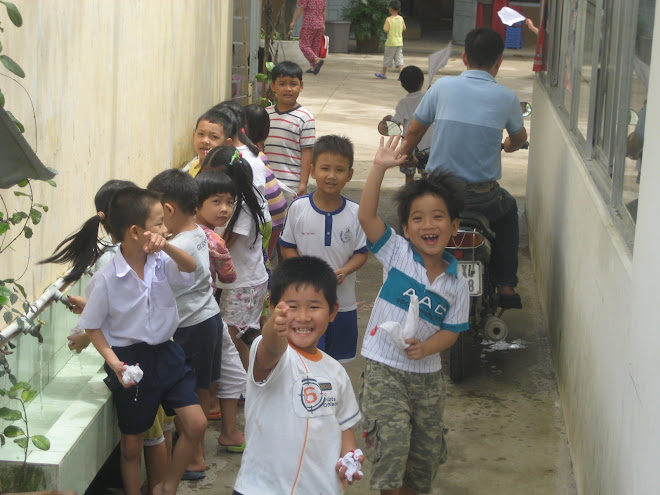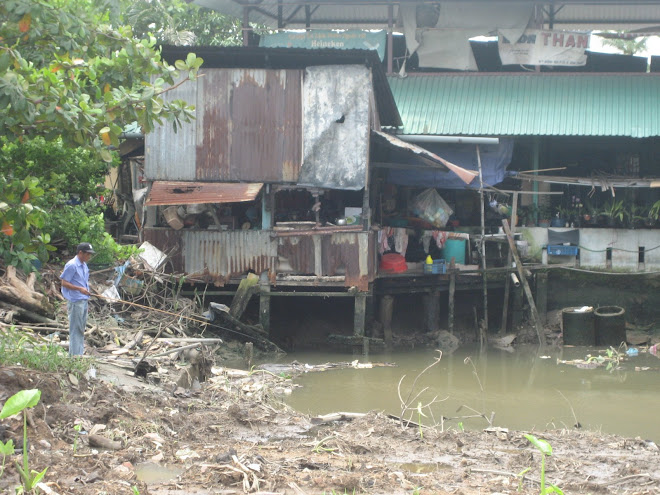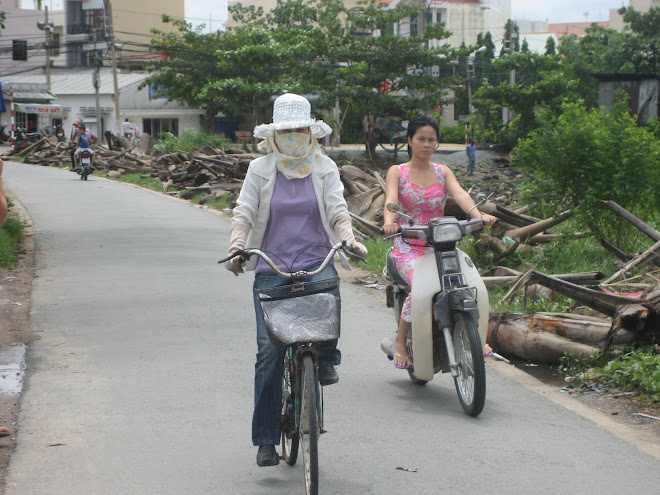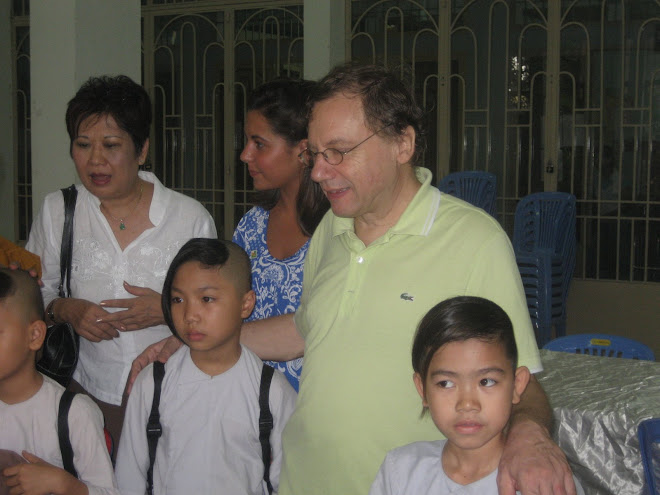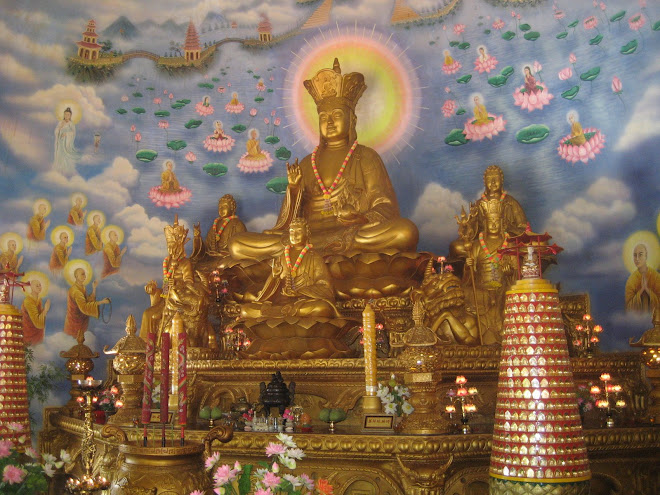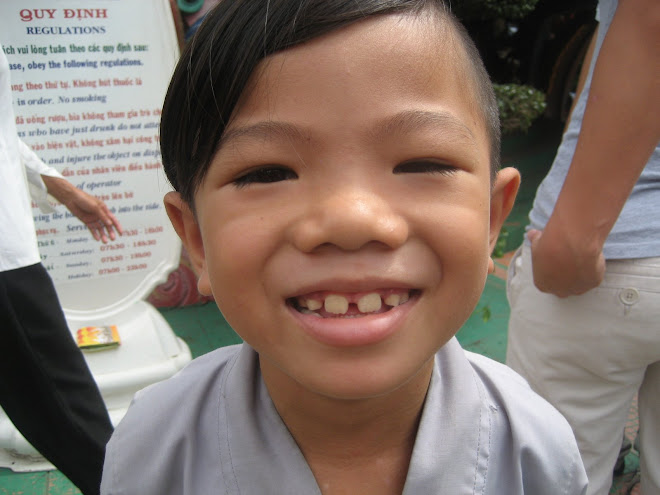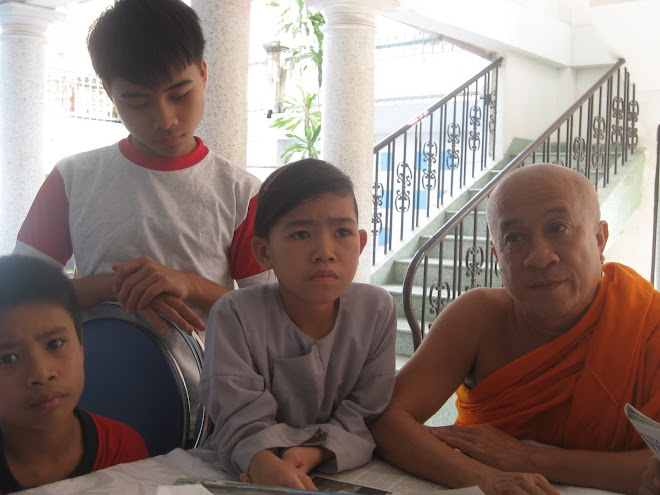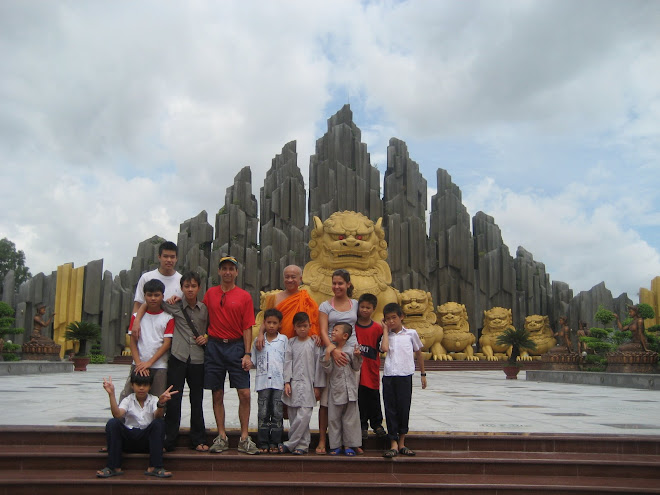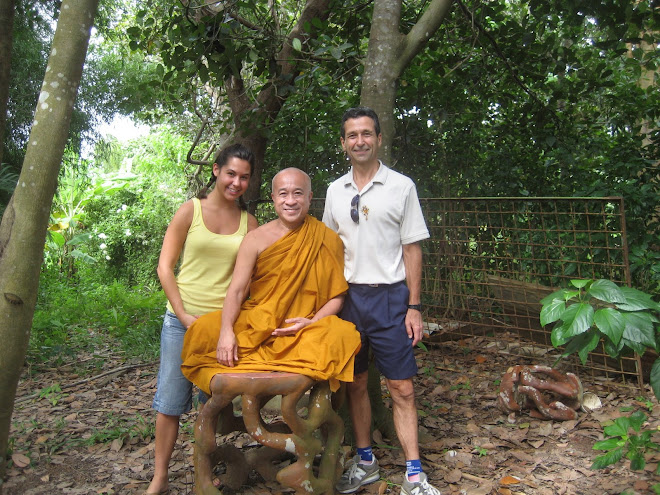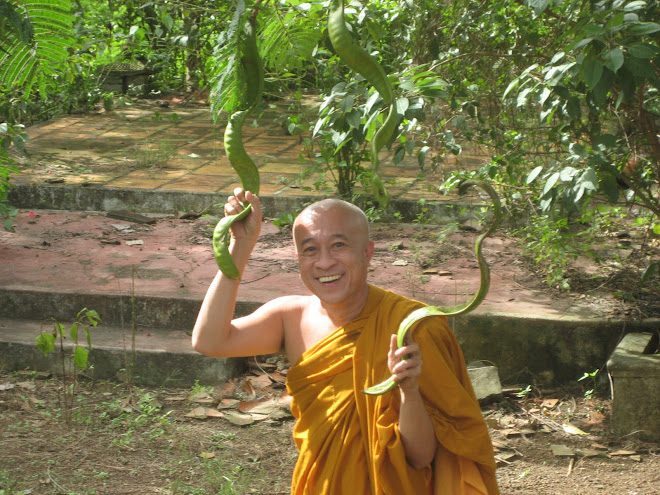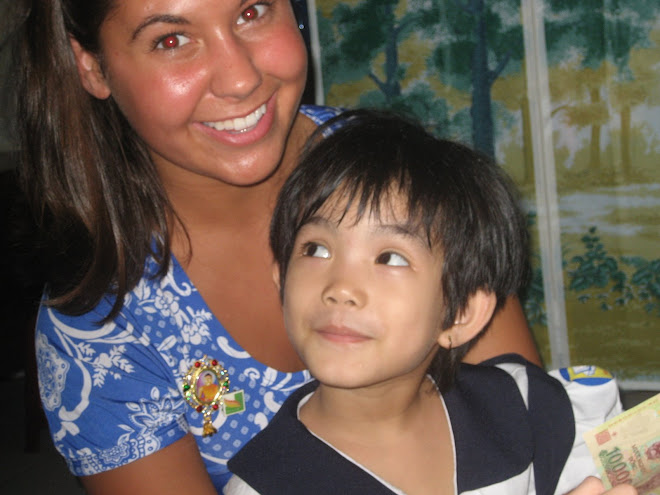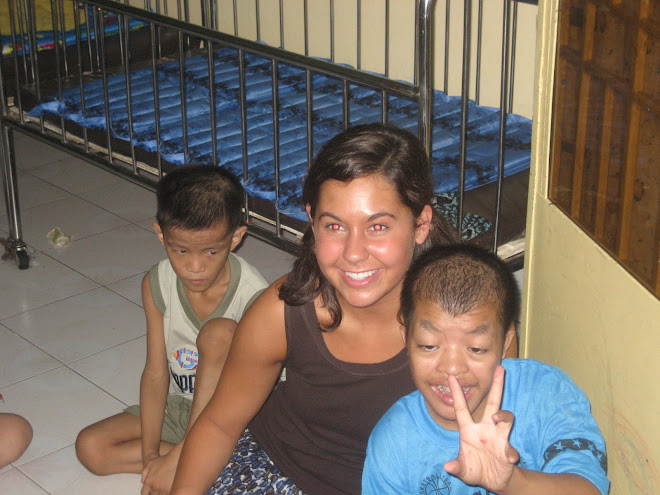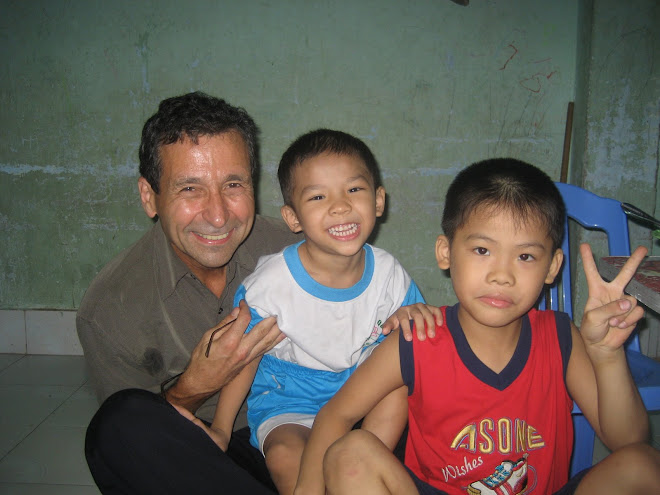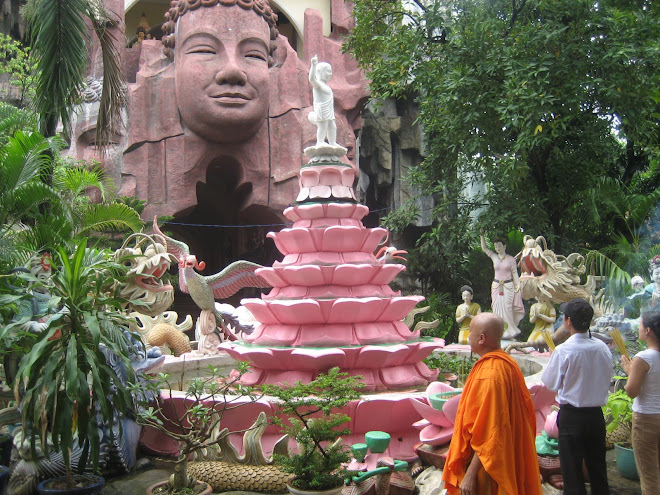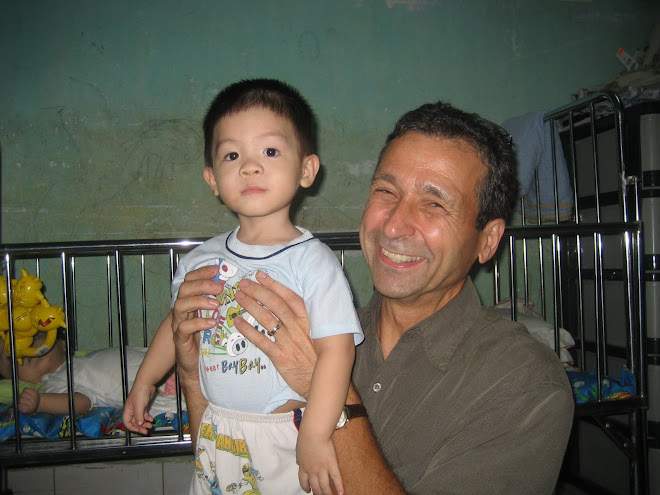31JULY07 – The Pagoda “Garden of Eden” + Random Thoughts on Vietnam
The Faure B&B is immaculate, writing my blog at the computer around 6am yesterday morning, I observed why, as the young “chambermaid” Diem (“diem”) wet mopped and dusted every surface in the house before breakfast. That includes the front steps – the front double doors to the house are always open but the front gate is always locked. I must take some pictures of the wonderful countenance of the cook and caretaker, Duyen. She's about 4'6" with a smile that would melt anyone, and we are "buds" despite not being able to exchange anything but sign language! She also fixes the best Iced Coffee I've ever had - I'm getting a slight addiction!!
My main difficulty here is waiting to be served and asking for everything rather than getting it for myself. I much prefer to be self-sufficient and helpful – but I’m afraid it is an insult to do anything for myself here.
The diet is so healthy – I don’t think anyone exercises and there is not that much manual labor in the city and yet everyone is thin – the primary protein source is tofu, fried or boiled, and put in virtually every soup and rice dish, along with bean sprouts and local fish. According to Phillipe, the Vietnamese are fiercely independent compared to the Chinese and Japanese – much more like the Germans or French who have a very independent philosophy. Although there are some large high-rise apartments, they were largely built by foreign investors who didn’t understand that the local people would much prefer a very small house – a 12 to 15 foot store front by 40 ft deep with 1 or 2 stories of living space above it – than an apartment in a luxury building..
The prices are so interesting – initially unpredictable -- I think I am beginning to understand the basics:
Land is very scarce since Vietnam has more than double the population of California (84 million to 38) and less than half the land mass;
Natural resources are limited and expensive;
Imports or goods produced with imported energy or technology are expensive;
Anything based on local labor and local renewable resources is cheap.
Thus, a big house like Phillipe’s is worth $1.6 million but an hour professional massage is $3 or $4 and the basic food like rice and local vegetables and fruit are equally inexpensive.
To begin our day’s adventure, after a morning 5-mile run and “photo-trip” around the “neighborhood,” Mr. Chau and one of his young driver monks came in a 12-person van for a wonderful, and somewhat different, lunch at the Faure’s home: first course of shredded red and green cabbage, carrots, fried tofu, a few other unknown vegies; second course of stir fried veggies – mushrooms, a black rubbery tree fungus, green beans; final course of soup with several kinds of large beans/peas like giant black-eyed peas and lima beans, thick slippery rice noodles, coconut milk sauce, some sweeter fruit type things. [I was gently chastised for trying to eat the third course first!]
It was a long ride in the countryside out to the huge farm owned by the Pagoda: 66 km or about 40 miles but it took us 1hr 45 min. – averaging about 23mpg – with maybe 2 stoplights in the city. If possible, the traffic pattern is worse in the country than the city in that there are more bicycles, trucks, backhoes, tractors, buses and every slow moving type of vehicle you can imagine mixed in with the same dizzying array of motorbikes swerving everywhere. But the same speed limit prevailed: ignore the posted speed limit and go as fast as you dare (without hitting anyone)!
One interesting construction note: on the dirt road leading to the firm, the road builders had dumped a half mile of 2 – 4 inch sq. rocks, piled 3 ft. high on half the road, which reduced the 2 lane road to 1 lane, such that meeting cars had to back up to find a place where they could pass. We could see down the way where a team of men were shoveling the rocks over the full road and a steamroller was smoothing them into the dirt – not US construction standards, even in TN!
Arriving at the farm, we had no idea what to expect – but it was an incredible “Garden of Eden” with dozens of crops including rubber trees, bananas, mangoes, potatoes, Vietnamese medicinal herbs. The farm is 50 hectares: 1 hectare equals 10,000 sq. meters, or 2.5 meters = 125 acres. Apparently Mr. Chau first bought the land for the Ky Quang II Pagoda in 1996 with the idea of building the Orphanage there – he had less than 30 children at that time at Ky Quang II in HCMC. But the government wouldn’t approve the plan so he has expanded Ky Quang II to accommodate the 216 children they have now. [“Children” really means dependents since there are blind and semi-paralyzed residents as old as 35 and many blind students in the massage training program in their 20’s and 30’s.] But the plan remains to build a children’s center in the country there where the children can have land to live on rather than being in their small rooms in the city, and learn to cultivate the variety of crops that can grow there including dairy cattle. There were a couple families who lived there in rustic, if dilapidated surroundings, and a beautiful 9 month old boy who Aly quickly befriended!
On the way back. Mr. Chau asked Aly if she would remember him when she went home. She immediately exclaimed: “of course, I LOVE you!” which is no exaggeration, and you can see he has a great affection for her as well. I think it has been as a great bonding as I had hoped for with Aly and both the children and Mr. Chau. He is so accessible and so open, kind and affectionate with everyone – and has taken at least half of each day to spend with us! Being with him feels like the difference between being with a “holy man” and a “minister/administrator of the church.” The other memorable discussion we had was sitting having a glass of “lemonade” – which we were afraid to drink since it was not bottled or boiled water, but I risked a little anyway to be polite. Mr. Chau asked: why do you give your funds to us, is it to have a better life in heaven? He explained that for him doing good deeds created good karma, which creates better life in your next reincarnation. I explained that for me, it comes down to the simple imperative that if I or my loved ones were in need, I would want someone who had more than they needed to share. So that ethic is my duty since I have more than I need. It’s hard to say what he thought of that, except that my actions would create good karma and a good reincarnation, which I don’t totally discount.
We ended the ride back with some back and head massages – now that’s something you don’t expect to give and receive from just any “man of the cloth!”
Tuesday, July 31, 2007
Monday, July 30, 2007
Day Two at the Pagoda + the Massage Retreat Center
9:30PM: Today was the day of celebrations at the Pagoda in appreciation for the gift from the Center for Contemplative Justice in Nashville. We left at 8:15 to get to the Pagoda and I was wrong about one thing: there is a “rush hour” – it was virtual gridlock getting into the city across the Saigon River bridge. The river is a typical “rain forest” river – muddy brown, with many large clumps of water vegetation floating down stream. It’s not as large as I expected, probably less water than the Cumberland for example.
When we arrived at the Pagoda, the young children (2 – 10), probably 80 to 100 of them, were assembled in the meeting hall. It was amazing to see the children sitting so quietly waiting for us – especially after seeing how “spirited” they were in their own rooms on Saturday. Ven. Mr. Chau had special gifts assembled for us to distribute – a new school uniform (white shirt/blouse, navy pants/jumper - very cute) plus a 10,000 Dang bill for each child (about 62 cents). I thought it was thoughtful for Mr. Chau to have us distribute the gifts to each child but I did not understand in the limited translation we got of the Vietnamese speeches that the gifts were purchase “on our behalf” and the children were told we were bringing them gifts of love and care from America. All of this was recorded by a special video and still photographer – who at the end of the day asked me how long a video I would like – apparently Mr. Chau is having a video made for us! That was NOT good news to Aly! It is quite embarrassing to be the center of attention in this way – especially when it is such a gift to be here and experience the humility and joy of the people. However the last thing we want to do is appear to ungrateful and unaccepting of their kindness so we try as best we can to appreciate everything.
For the next 2 hours, we went to each of the child rooms again starting with the oldest and most handicapped children. We were much more comfortable today in holding, touching and talking to the children. It’s difficult to know what the most handicapped ones perceive since they don’t speak and often don’t smile and we have no experience with children with these severe disabilities. Many have misformed hands and feet, some are emaciated despite having all they want to eat. I come back to the phrase of Mother Teresa that she sees “God in every face” as I try to engage each child.
Then Mr. Chau hosted us for an elaborate vegan lunch with four of the monks, all 20 to 30 years old, and a group of about 30 volunteers from the University. Apparently these are the only male monks there except for about 5 “novices” who are 10 to 12 years old and look about 7 or 8. It seems a bit sad to have these pre-adolescent boys entering this enveloping community but we certainly don’t understand their circumstances or want this means culturally to them. We got some beautiful pictures of the novices that we will post at the end of the blog. We were a little hesitant about the food, not knowing what kind of water is used in the cooking and how it would go with our Western stomachs – but it was delicious and “so far so good 10 hours later!” We had about 6 different dishes including a great curry soup with vegetables and tofu that I concentrated on.
After lunch we went to a new “resort center” that Mr. Chau has somehow acquired, with the goal of making it into a retreat center with musical entertainment. He seems incredibly entrepreneurial for a holy man – especially when he doesn’t seem to have any business manager or real financial advisor.
However, I had some severe doubts about this place as we headed off the main road into the first semi-rural slum we had seen: a half-flooded dirt road, with a string of dilapidated houses and businesses on the right and an intimidating and polluted looking ditch/stream on the left. However, after perhaps a slow ¼ mile, we came upon a very surprising sight, starting with two tile life-size giraffes “eating” leaves from a tree.
The retreat center is a beautiful and elaborate place – perhaps 5 acres – on the Saigon River, with a “band shell,” a bar area (who knows if the Buddhists will serve alcohol) and a “spa” where the blind students will give massages. There are two dormitories for the girls/women and men (18 to 30 years old), respectively. Mr. Chau seems so relaxed and happy to walk around with us showing us each of the buildings and the elaborate grounds. Right before we left, we climbed into a little gazebo, perhaps 8 x 8, with a thatched roof but open air sides, perhaps 3 feet off the ground, which is used now for meditation. He asked us to sit in the half-lotus and lotus positions and asked if we felt the peace of the place when we were sitting there, which we did. Very cool!
After the tour we came back for a similar celebration and gift presentation to the blind students. We had not seen them before, apparently they live and have their education and training courses on the second floor. Again we gifts to each of about 80 people - much older ranging from 18 to one man about 60. This speech by the teachers about us was so touching that some of the students cried, I think they are overwhelmed when people come from around the world to care for them. It's an image and experience that we won't soon forget.
There are a couple pictures below, we will try to post more later - waiting to hear some comments!
When we arrived at the Pagoda, the young children (2 – 10), probably 80 to 100 of them, were assembled in the meeting hall. It was amazing to see the children sitting so quietly waiting for us – especially after seeing how “spirited” they were in their own rooms on Saturday. Ven. Mr. Chau had special gifts assembled for us to distribute – a new school uniform (white shirt/blouse, navy pants/jumper - very cute) plus a 10,000 Dang bill for each child (about 62 cents). I thought it was thoughtful for Mr. Chau to have us distribute the gifts to each child but I did not understand in the limited translation we got of the Vietnamese speeches that the gifts were purchase “on our behalf” and the children were told we were bringing them gifts of love and care from America. All of this was recorded by a special video and still photographer – who at the end of the day asked me how long a video I would like – apparently Mr. Chau is having a video made for us! That was NOT good news to Aly! It is quite embarrassing to be the center of attention in this way – especially when it is such a gift to be here and experience the humility and joy of the people. However the last thing we want to do is appear to ungrateful and unaccepting of their kindness so we try as best we can to appreciate everything.
For the next 2 hours, we went to each of the child rooms again starting with the oldest and most handicapped children. We were much more comfortable today in holding, touching and talking to the children. It’s difficult to know what the most handicapped ones perceive since they don’t speak and often don’t smile and we have no experience with children with these severe disabilities. Many have misformed hands and feet, some are emaciated despite having all they want to eat. I come back to the phrase of Mother Teresa that she sees “God in every face” as I try to engage each child.
Then Mr. Chau hosted us for an elaborate vegan lunch with four of the monks, all 20 to 30 years old, and a group of about 30 volunteers from the University. Apparently these are the only male monks there except for about 5 “novices” who are 10 to 12 years old and look about 7 or 8. It seems a bit sad to have these pre-adolescent boys entering this enveloping community but we certainly don’t understand their circumstances or want this means culturally to them. We got some beautiful pictures of the novices that we will post at the end of the blog. We were a little hesitant about the food, not knowing what kind of water is used in the cooking and how it would go with our Western stomachs – but it was delicious and “so far so good 10 hours later!” We had about 6 different dishes including a great curry soup with vegetables and tofu that I concentrated on.
After lunch we went to a new “resort center” that Mr. Chau has somehow acquired, with the goal of making it into a retreat center with musical entertainment. He seems incredibly entrepreneurial for a holy man – especially when he doesn’t seem to have any business manager or real financial advisor.
However, I had some severe doubts about this place as we headed off the main road into the first semi-rural slum we had seen: a half-flooded dirt road, with a string of dilapidated houses and businesses on the right and an intimidating and polluted looking ditch/stream on the left. However, after perhaps a slow ¼ mile, we came upon a very surprising sight, starting with two tile life-size giraffes “eating” leaves from a tree.
The retreat center is a beautiful and elaborate place – perhaps 5 acres – on the Saigon River, with a “band shell,” a bar area (who knows if the Buddhists will serve alcohol) and a “spa” where the blind students will give massages. There are two dormitories for the girls/women and men (18 to 30 years old), respectively. Mr. Chau seems so relaxed and happy to walk around with us showing us each of the buildings and the elaborate grounds. Right before we left, we climbed into a little gazebo, perhaps 8 x 8, with a thatched roof but open air sides, perhaps 3 feet off the ground, which is used now for meditation. He asked us to sit in the half-lotus and lotus positions and asked if we felt the peace of the place when we were sitting there, which we did. Very cool!
After the tour we came back for a similar celebration and gift presentation to the blind students. We had not seen them before, apparently they live and have their education and training courses on the second floor. Again we gifts to each of about 80 people - much older ranging from 18 to one man about 60. This speech by the teachers about us was so touching that some of the students cried, I think they are overwhelmed when people come from around the world to care for them. It's an image and experience that we won't soon forget.
There are a couple pictures below, we will try to post more later - waiting to hear some comments!
Sunday, July 29, 2007
HCMC Traffic and the Cu Chi Tunnels
30JULY07 – I’m up early again today (3:45am) – good time to reflect on yesterday’s trip to Cu Chi. Aly was gung-ho to see the Cu Chi Tunnel System ruins – an integral part of the Viet Cong victory in the American War. We engaged a driver for the 1.5 hour trip there (maybe 30 miles – with the first 10 through the city) for an intimidating 500,000 Dang. But once you figure out the math, at 16,100 Dang / US$, that’s $32 for a 5 hour trip including all gasoline – in an air conditioned, immaculate Toyota mini-SUV with the headrests covered in hand-made white tablecloth linen.
But before describing the trip and ruins, my top 10 list of reasons I love the traffic system:
10. It’s a lot like “bumper cars,” which I find really fun, but without the bumping. What adds to the excitement is the variety of sizes and speeds of the vehicles – imagine bumper cars that included Escalades and tricycles, with a few pedestrians thrown into the mix. The parallels to bumper cars include: there are no lanes, right of ways, or any pattern of speed or expectation representing the “rules of the road.”
9. It’s basically the “law of the jungle,” with a Buddhist philosophy that all life is sacred and everyone is to be respected equally. The traffic “law of the jungle” is based on size – the bigger your vehicle the greater your right of way – but the Buddhist twist is that you then have responsibility to warn / avoid the smaller vehicles including bikes and pedestrians.
8. There is no rush hour, or more accurately, there is no difference in the constancy of the rush hour norm that lasts from 6am to midnight 7 days a week. There was as much congestion at 10AM Sunday morning on the way to Cu Chi as Saturday afternoon – we shall see about Monday morning when we leave about 8:30 for the Pagoda.
7. The variety of motorbike transport items is a never-ending source of entertainment, in fact it’s almost a contest to see who can get the longest, heaviest, tallest and most unusual “stuff” on his/her motorbike:
teenagers with 20 foot long sections of plastic or metal pipe or building materials, or multiple sections of plate glass windows, or stacks of bricks;
old men with 6 or 7 50-lb sacks of what look to be onions strapped everywhere, including 1 or 2 huge bags between the driver and the handle bars;
families with two to four children – after all the motorbike IS the family vehicle so when the family has an outing, everyone piles on. [Philippe notes that as a matter of safety, the government has enacted new laws requiring helmets and restricting the number of passengers to two adults and one child – however, I would say no more than 20% of people wore helmets, and I never saw one on a child, plus many families pile all of their children on with the parents.]
6. Ninety percent or more of the women wear masks of some type, typically colorful cloth covering up to their eyes, sometimes scarves wrapped around their heads – the primary purpose is to avoid the sun and getting more of a tan since “pale is beautiful” in the Vietnamese culture. There are some practical benefits in terms of reducing the pollution breathed and the facial “road grit” that must be churned up by the sea of motorbikes.
5. There are no stop signs! None! Nada! It’s heaven! Not in the city, not in the country! The only “traffic controls” are the traffic lights at the major intersection in the city. And the lights have a little timer that counts down the seconds before it will turn green. In the city, it’s the responsibility of the cross traffic to “ease into” the flow, but at the same time the “flow” must swerve and accommodate them. In the countryside, the “through traffic” slows at every intersection and honks to alert the side traffic not to simply zip across at full speed. Thus, all of the traffic rules seem to distill down to two: “never stop” but “don’t hit anyone.”
4. Honking is beautiful! Honking is the communication of choice to signal one’s intentions and location – rather than being an ignominious badge of “road rage,” honking is the polite way to communicate, as evidenced by the greater frequency of honking by Mr. Chau than the taxi drivers we’ve ridden with.
3. Everyone drives incredibly slowly by U.S. standards, but because of the constant swerving and “video game” driving conditions, it feels incredibly fast. The posted speed limits range from 15 km/hr on the narrowest streets (9.6 mph) to 25km/hr (15.8 mph) on the typical 2-way streets to 40 km/hr (24.8) on the 6 lane thoroughfares. The average speed is probably 40% to 60% higher than the posted speed (i.e., 30 to 40 mpg on the thorough fares),
2. All traffic behavior is on the “honor system” – we have yet to see a police car or any military or other police official who appeared to be concerned with enforcement of the traffic laws.
1. Although I have protested otherwise since I arrived, I am now forced to admit that if I were here on my own or lived here I would definitely “plunge into the fray,” on my bicycle if possible – how could I resist this “bungie-jumping” approach to getting around!
The Visit to the Cu Chi Tunnels
Returning to our trip to the Cu Chi Tunnels, the car ride was exceedingly comfortable and interesting. The most striking single thing we observed was the absence of any sign of rural poverty. We saw no shacks or shanties at all – every house was built of stucco or brick with a metal or ceramic tile roof. Everything was green and lush – how could it not be – it’s rained an average of 2 inches a day for our first 3 days here, at this rate HCMC will top Nashville’s 50 inches of annual rainfall in less than a month, and the rainy season is 6 months long from June to November. People were working in many of the rice fields – walking on narrow raised mud borders between the flooded or semi-flooded plants. Lots of cows, a few horses. We stopped to examine the trees in a rubber tree farm – a tiny woman (maybe 4’4”) was working to collect the milky latex that drips into a bowl strapped to each tree below a small “trough” at the end of a barber pole slice around the tree’s bark.
The roads were very good but narrow – it was intimidating to meet another car or bus, especially with the number of pedestrians, families sitting on the edge of the pavement, bicycles and motorbikes – and no one stopped at any intersection!
Arriving at the Cu Chi Tunnel Ruins, my first impression was my trip to communist Yugoslavia under Tito in 1966 – old style Communist propaganda with pictures everywhere of the beloved comrade leader, this time Ho Chi Minh instead of Tito. Apart from the flat screen tv’s that showed the scratchy black and white propaganda films that appeared to have been made in the mid 70’s right after the war ended, everything at the Ruins looked to be 40 or 50 years sold.
The history of the Cu Chi Tunnels is fascinating – approximately 16,000 Viet Cong lived underground in 150 miles of multi-layered system of tunnels just 15 to 30 miles from Saigon city center. Originally built in the 1940’s by the Viet Minh peasant guerrilla army to fight the superior military technology of the French Army, the tunnels were dramatically expanded in the 1960’s to fight an even more technically sophisticated American Army. The system included sleeping quarters, kitchens, dining halls, military planning rooms, munitions factories (primarily recycling of American undetonated bombs into bullets, grenades and land mines) and hospitals. With many under-water and hidden jungle trapdoor entrances, the VC were able to stage surprise military attacks at will and then virtually disappear.
For every American tactic adopted: using trained dogs; sending U.S. military into the tunnels that were located; carpet bombing and eventually using chemical warfare to indiscriminately kill the villagers and destroy their crops and land, the VC adapted a new guerilla strategy. It is eerie to “walk” through the 3 foot high 2 feet wide tunnels, even a short distance. And very intimidating to go around a curve that is in complete darkness. However, the tunnel quickly recovers into light after a few feet of “groping trust” that we won’t fall into an unseen abyss or be attacked by some snake or reptile who decided to take up residence. We were glad to be up safely on the ground again after just 50 yards or less of “tunneling.” Two other highlights:
1. The rusting ruin of a US tank that remains as a battlefield artifact, a dilapidated “tomb of the unknown soldier;” and
2. Firing an AK47 U.S. assault rifle, presumably remaining from the war, at a target range. Neither Aly or I have ever hunted or even like guns, but shooting a weapon of war surrounded by the remnants of an incredibly brutal and unjust U.S. invasion was a powerful experience.
Despite “winning” the war, the toll on the VC was horrific, only 6,000 of the 16,000 troops living in the tunnels survived. Thus, while the “exhibits” [mostly dugout “rooms” 8 to 10 feet down with thatched roofs to keep out the rain] are an almost amusing barrage of Communist propaganda of how the peace-loving women and children of Cu Chi, fought the American invaders to protect the homes and fields, the stark reality of the American decimation of the people and land is abundantly clear. This was a battlefield, still pock-marked with 20 foot deep 40 foot wide B-52 bomb craters. And the land and water is still poisoned with napalm and dioxin – creating frighteningly high birth defect rates and low crop yields. There is simply no excuse for what the U.S. did here.
But before describing the trip and ruins, my top 10 list of reasons I love the traffic system:
10. It’s a lot like “bumper cars,” which I find really fun, but without the bumping. What adds to the excitement is the variety of sizes and speeds of the vehicles – imagine bumper cars that included Escalades and tricycles, with a few pedestrians thrown into the mix. The parallels to bumper cars include: there are no lanes, right of ways, or any pattern of speed or expectation representing the “rules of the road.”
9. It’s basically the “law of the jungle,” with a Buddhist philosophy that all life is sacred and everyone is to be respected equally. The traffic “law of the jungle” is based on size – the bigger your vehicle the greater your right of way – but the Buddhist twist is that you then have responsibility to warn / avoid the smaller vehicles including bikes and pedestrians.
8. There is no rush hour, or more accurately, there is no difference in the constancy of the rush hour norm that lasts from 6am to midnight 7 days a week. There was as much congestion at 10AM Sunday morning on the way to Cu Chi as Saturday afternoon – we shall see about Monday morning when we leave about 8:30 for the Pagoda.
7. The variety of motorbike transport items is a never-ending source of entertainment, in fact it’s almost a contest to see who can get the longest, heaviest, tallest and most unusual “stuff” on his/her motorbike:
teenagers with 20 foot long sections of plastic or metal pipe or building materials, or multiple sections of plate glass windows, or stacks of bricks;
old men with 6 or 7 50-lb sacks of what look to be onions strapped everywhere, including 1 or 2 huge bags between the driver and the handle bars;
families with two to four children – after all the motorbike IS the family vehicle so when the family has an outing, everyone piles on. [Philippe notes that as a matter of safety, the government has enacted new laws requiring helmets and restricting the number of passengers to two adults and one child – however, I would say no more than 20% of people wore helmets, and I never saw one on a child, plus many families pile all of their children on with the parents.]
6. Ninety percent or more of the women wear masks of some type, typically colorful cloth covering up to their eyes, sometimes scarves wrapped around their heads – the primary purpose is to avoid the sun and getting more of a tan since “pale is beautiful” in the Vietnamese culture. There are some practical benefits in terms of reducing the pollution breathed and the facial “road grit” that must be churned up by the sea of motorbikes.
5. There are no stop signs! None! Nada! It’s heaven! Not in the city, not in the country! The only “traffic controls” are the traffic lights at the major intersection in the city. And the lights have a little timer that counts down the seconds before it will turn green. In the city, it’s the responsibility of the cross traffic to “ease into” the flow, but at the same time the “flow” must swerve and accommodate them. In the countryside, the “through traffic” slows at every intersection and honks to alert the side traffic not to simply zip across at full speed. Thus, all of the traffic rules seem to distill down to two: “never stop” but “don’t hit anyone.”
4. Honking is beautiful! Honking is the communication of choice to signal one’s intentions and location – rather than being an ignominious badge of “road rage,” honking is the polite way to communicate, as evidenced by the greater frequency of honking by Mr. Chau than the taxi drivers we’ve ridden with.
3. Everyone drives incredibly slowly by U.S. standards, but because of the constant swerving and “video game” driving conditions, it feels incredibly fast. The posted speed limits range from 15 km/hr on the narrowest streets (9.6 mph) to 25km/hr (15.8 mph) on the typical 2-way streets to 40 km/hr (24.8) on the 6 lane thoroughfares. The average speed is probably 40% to 60% higher than the posted speed (i.e., 30 to 40 mpg on the thorough fares),
2. All traffic behavior is on the “honor system” – we have yet to see a police car or any military or other police official who appeared to be concerned with enforcement of the traffic laws.
1. Although I have protested otherwise since I arrived, I am now forced to admit that if I were here on my own or lived here I would definitely “plunge into the fray,” on my bicycle if possible – how could I resist this “bungie-jumping” approach to getting around!
The Visit to the Cu Chi Tunnels
Returning to our trip to the Cu Chi Tunnels, the car ride was exceedingly comfortable and interesting. The most striking single thing we observed was the absence of any sign of rural poverty. We saw no shacks or shanties at all – every house was built of stucco or brick with a metal or ceramic tile roof. Everything was green and lush – how could it not be – it’s rained an average of 2 inches a day for our first 3 days here, at this rate HCMC will top Nashville’s 50 inches of annual rainfall in less than a month, and the rainy season is 6 months long from June to November. People were working in many of the rice fields – walking on narrow raised mud borders between the flooded or semi-flooded plants. Lots of cows, a few horses. We stopped to examine the trees in a rubber tree farm – a tiny woman (maybe 4’4”) was working to collect the milky latex that drips into a bowl strapped to each tree below a small “trough” at the end of a barber pole slice around the tree’s bark.
The roads were very good but narrow – it was intimidating to meet another car or bus, especially with the number of pedestrians, families sitting on the edge of the pavement, bicycles and motorbikes – and no one stopped at any intersection!
Arriving at the Cu Chi Tunnel Ruins, my first impression was my trip to communist Yugoslavia under Tito in 1966 – old style Communist propaganda with pictures everywhere of the beloved comrade leader, this time Ho Chi Minh instead of Tito. Apart from the flat screen tv’s that showed the scratchy black and white propaganda films that appeared to have been made in the mid 70’s right after the war ended, everything at the Ruins looked to be 40 or 50 years sold.
The history of the Cu Chi Tunnels is fascinating – approximately 16,000 Viet Cong lived underground in 150 miles of multi-layered system of tunnels just 15 to 30 miles from Saigon city center. Originally built in the 1940’s by the Viet Minh peasant guerrilla army to fight the superior military technology of the French Army, the tunnels were dramatically expanded in the 1960’s to fight an even more technically sophisticated American Army. The system included sleeping quarters, kitchens, dining halls, military planning rooms, munitions factories (primarily recycling of American undetonated bombs into bullets, grenades and land mines) and hospitals. With many under-water and hidden jungle trapdoor entrances, the VC were able to stage surprise military attacks at will and then virtually disappear.
For every American tactic adopted: using trained dogs; sending U.S. military into the tunnels that were located; carpet bombing and eventually using chemical warfare to indiscriminately kill the villagers and destroy their crops and land, the VC adapted a new guerilla strategy. It is eerie to “walk” through the 3 foot high 2 feet wide tunnels, even a short distance. And very intimidating to go around a curve that is in complete darkness. However, the tunnel quickly recovers into light after a few feet of “groping trust” that we won’t fall into an unseen abyss or be attacked by some snake or reptile who decided to take up residence. We were glad to be up safely on the ground again after just 50 yards or less of “tunneling.” Two other highlights:
1. The rusting ruin of a US tank that remains as a battlefield artifact, a dilapidated “tomb of the unknown soldier;” and
2. Firing an AK47 U.S. assault rifle, presumably remaining from the war, at a target range. Neither Aly or I have ever hunted or even like guns, but shooting a weapon of war surrounded by the remnants of an incredibly brutal and unjust U.S. invasion was a powerful experience.
Despite “winning” the war, the toll on the VC was horrific, only 6,000 of the 16,000 troops living in the tunnels survived. Thus, while the “exhibits” [mostly dugout “rooms” 8 to 10 feet down with thatched roofs to keep out the rain] are an almost amusing barrage of Communist propaganda of how the peace-loving women and children of Cu Chi, fought the American invaders to protect the homes and fields, the stark reality of the American decimation of the people and land is abundantly clear. This was a battlefield, still pock-marked with 20 foot deep 40 foot wide B-52 bomb craters. And the land and water is still poisoned with napalm and dioxin – creating frighteningly high birth defect rates and low crop yields. There is simply no excuse for what the U.S. did here.
Saturday, July 28, 2007
A Day at the Pagoda - Ky Quang II
28JULY07 – Nothing prepares you for a “Day at the Pagoda!” Getting there is an extraordinary adventure in itself. The only way to describe the traffic pattern of motorbikes (mixed with bicycles, cars and buses in a ratio of about 50:1, 500:1, and 5000:1 respectively) is to imagine a swarm of bees on a hive, each knowing its objective and working very hard to achieve it, but to the outside observer all appears to be chaos. Traveling at varying speeds from 15 to 40mph (while dodging the bikes traveling at 5 to 15mph), the motor bikes weave in and out generally 3 to 5 abreast on two-way streets barely wide enough for 2 cars to meet, with no traffic lights or breaks in the flow. Thus, with 6 to 10 motorbikes weaving in opposite directions at any instant, a left turn across the oncoming traffic generally is negotiated by moving onto the wrong side of the road to establish one’s intention and then gradually moving left while the oncoming motor bikes swerve to their left to avoid the head-on collision. And pedestrians? Forget it, burn some incense in the temple and just step right out since there will never be a break in the traffic, just take on faith that everyone will swerve around you!
In this teeming city of 8 million (1/3 of which are here “illegally” having been removed to the countryside by the Communist regime as supporters of the South in the “American War” or relegated to the rural area), we whiz past literally thousands of retail outlets – every street between our residence and the Pagoda (probably 10 miles or so) has wall to wall buildings, typically about 15 ft wide, with the ground floor selling something highly specialized (don’t ask me what in most cases!) These are hard-working folks – very few appear to have any customers but the shops are open from 5AM to 9PM 7 days a week just in case. We recognize three or four English names near a few of the bigger “upscale” intersections: Internet, Karaoke, KFC and Beer Pub. Finally we branch off into an even smaller street – should be a one-way but of course it’s not – we come upon a surreal sight: the Ky Quang II Pagoda (“KQII”) and Handicapped Children Center.
KQII rises like a Disney attraction out of nowhere – built to look like a volcanic mountain maybe 50 feet high – where the roller coaster should be emerging is the smiling 20 foot Buddha face “carved” into the mountain and painted reddish-pink. A 20 foot high gold arched entrance is surrounded by gold carvings of dragons and other mythological creatures. As we drive past the incense vendors into the courtyard, full of at least 100 parked motorbikes, the sights and smells are overwhelming. KQII fills about half of a US city block – and is home to 216 mostly handicapped children (about 20 or so of the infants and toddlers are normal and in addition to going to school become employed as caretakers of the handicapped children) and about 90 monks, mostly slight unisex women with shaved heads and dull gray robes. Before we can fully acclimate to the fountains, carvings, and small prayer enclaves with intricate gold figures, Ven. Thich Thien Chieu (“Mr. Chau” for westerners) comes up to greet us dressed in the traditional saffron robes. Barely 5 feet tall with a beatific smile, he presents Aly with a basket of red roses and pink orchids and welcomes us profusely.
On the way to visit the children, housed in two stories of rooms loosely connected to the back of the Pagoda, we first come to the medical clinic. Mr. Chau shows us the register book, which records the name, diagnosis, and “prescription” given to each of the 300 to 400 people seen each day. There are two herbal doctors who make the diagnoses – all of the prescriptive remedies come from 20 to 30 different kinds of herbs found in 18 in. by 3 ft. white plastic rice sacks (that hold 100 lbs of rice or so). The “pharmacists” lay out 5 or 6 sheets of tabloid shaped newspaper, and reading the prescription list of herbs to be mixed, sprinkle an imprecise handful of each ingredient into the middle of each sheet. The prescriptions typically have 8 to 12 different herbs – all very dry – the obvious ones being different tree barks but most are dried to a greenish brown and emit little smell. Once the prescription is filled, the sheets are folded up, “tied” with a rubber band, and the 5 or so little identical packages are put in a plastic bag for the patient. Each daily prescription parcel is designed to be boiled down over a period of many hours into a single cup of “tea,” the flavor of which I cannot imagine. Approximately 5% of the diagnosed entries say “HIV” – the remainder are unintelligible to us but include diabetes and other serious ailments.
I've run out of time - we are off to see the Cu Chi Tunnels so the experience with the children, monks and other caregivers will have to wait until we return!
The Cu Chi Tunnels were great, but back to yesterday's visit to the Pagoda (which I have learned is a place of worship rather than a shrine in Vietnam, but is just the opposite in China where a "temple" is a place of worship and a "pagoda" is a shrine).
After the clinic tour, we reach the rooms for the children. The first room we enter houses 10 or 12 children ages 6 mos. to about 3 ½. The children are in cotton blue shorts and t-shirt “uniforms.” Knowing that some children are HIV positive or have AIDS and all are a little shy when we first come in, we first awkwardly the observers. However, Mr. Chau is immediately on the floor hugging and laughing with the children. Thus, within a few minutes the active ones are in our arms and laughing at the camera images when we show them their own photos and those of the other children. There are several in cribs with severe disabilities who we don’t quite know how to approach – immediately to our left is a hydrocephalic girl who is crying and whose face appears to be in a permanent “scream.” I’m not sure what is the culturally appropriate reaction – but Aly jumps in to comfort the child and stroke her hair, so I take the arm of another similarly deformed child in another crib. It’s hard to know whether the 5 or 6 caregivers, all women but only half dressed as monks, consider us intruders or welcome partners. My conclusion is that the shyness and language barrier is the reason they hold back – since Mr. Chau is so effusive about us being there (as captured by his omnipresent camera-wielding assistant!)
The first room is the largest one we see – perhaps 15 x 20 and “self-sufficient” with a cooking stove, small washer and dryer, cribs for each child, and shelves with clothes and toys. Each room we visited thereafter had progressively older children. The children under 6 or 7 seemed to have a sufficient number of caregivers, but I’m not sure that was true for the older children. Every room had its own kitchen and cooked similar meals of rice, steamed vegetables and small amounts of meat – despite the fact that the monks are vegans. After the first room, we felt more and more comfortable with the children even though they were more severely handicapped – to the point that only the blind children could feed themselves. At the end of the afternoon, we had a long talk with Mr. Chau – he was so friendly and appreciative in inviting us to come back and spend the full day on Monday to: have a ceremony to accept our gift; give presents that he would prepare for all of the children; take us to another of his pagodas; visit the Pagoda’s farm where they raise vegetables and are interested in raising their own medicinal herbs, have lunch and dinner and stay for after dinner meditation with the monks. All in all, Mr. Chau was delightful and made us feel like honored guests – exuding the kind of delightful grace and energy that makes one feel content in his presence, even in the most foreign of surroundings.
It has been marvelous to have Philippe and his wife Xuan as our hosts - incredibly gracious -they have made us feel completely at home in their beautiful French-style "mansion" - 3 floors, 6 guest rooms on the 3rd floor with Phillipe's business office and their personal quarters on the second floor and the ground floor being the kitchen, open air (but covered dining room and 50 foot swimming pool that extends beyond the reach of the house). We have a "North American" Internet phone to call home and broadband Internet access plus a "family" to eat with an educate us about Vietnam and a wonderful Vietnamese cook who prepares amazing traditional Vietnamese rice, vegetable and chicken or fish (Talipia last night) dishes. Philippe and Xuan (and their 17-year old son Patrick) speak French as their first language, English as their second, and Xuan is fluent in Vietnamese so she acts as translator at the Orphanage. It's a beautiful and relaxing place to stay, surrounded by the teeming chaos of HCMC urban life.
In this teeming city of 8 million (1/3 of which are here “illegally” having been removed to the countryside by the Communist regime as supporters of the South in the “American War” or relegated to the rural area), we whiz past literally thousands of retail outlets – every street between our residence and the Pagoda (probably 10 miles or so) has wall to wall buildings, typically about 15 ft wide, with the ground floor selling something highly specialized (don’t ask me what in most cases!) These are hard-working folks – very few appear to have any customers but the shops are open from 5AM to 9PM 7 days a week just in case. We recognize three or four English names near a few of the bigger “upscale” intersections: Internet, Karaoke, KFC and Beer Pub. Finally we branch off into an even smaller street – should be a one-way but of course it’s not – we come upon a surreal sight: the Ky Quang II Pagoda (“KQII”) and Handicapped Children Center.
KQII rises like a Disney attraction out of nowhere – built to look like a volcanic mountain maybe 50 feet high – where the roller coaster should be emerging is the smiling 20 foot Buddha face “carved” into the mountain and painted reddish-pink. A 20 foot high gold arched entrance is surrounded by gold carvings of dragons and other mythological creatures. As we drive past the incense vendors into the courtyard, full of at least 100 parked motorbikes, the sights and smells are overwhelming. KQII fills about half of a US city block – and is home to 216 mostly handicapped children (about 20 or so of the infants and toddlers are normal and in addition to going to school become employed as caretakers of the handicapped children) and about 90 monks, mostly slight unisex women with shaved heads and dull gray robes. Before we can fully acclimate to the fountains, carvings, and small prayer enclaves with intricate gold figures, Ven. Thich Thien Chieu (“Mr. Chau” for westerners) comes up to greet us dressed in the traditional saffron robes. Barely 5 feet tall with a beatific smile, he presents Aly with a basket of red roses and pink orchids and welcomes us profusely.
On the way to visit the children, housed in two stories of rooms loosely connected to the back of the Pagoda, we first come to the medical clinic. Mr. Chau shows us the register book, which records the name, diagnosis, and “prescription” given to each of the 300 to 400 people seen each day. There are two herbal doctors who make the diagnoses – all of the prescriptive remedies come from 20 to 30 different kinds of herbs found in 18 in. by 3 ft. white plastic rice sacks (that hold 100 lbs of rice or so). The “pharmacists” lay out 5 or 6 sheets of tabloid shaped newspaper, and reading the prescription list of herbs to be mixed, sprinkle an imprecise handful of each ingredient into the middle of each sheet. The prescriptions typically have 8 to 12 different herbs – all very dry – the obvious ones being different tree barks but most are dried to a greenish brown and emit little smell. Once the prescription is filled, the sheets are folded up, “tied” with a rubber band, and the 5 or so little identical packages are put in a plastic bag for the patient. Each daily prescription parcel is designed to be boiled down over a period of many hours into a single cup of “tea,” the flavor of which I cannot imagine. Approximately 5% of the diagnosed entries say “HIV” – the remainder are unintelligible to us but include diabetes and other serious ailments.
I've run out of time - we are off to see the Cu Chi Tunnels so the experience with the children, monks and other caregivers will have to wait until we return!
The Cu Chi Tunnels were great, but back to yesterday's visit to the Pagoda (which I have learned is a place of worship rather than a shrine in Vietnam, but is just the opposite in China where a "temple" is a place of worship and a "pagoda" is a shrine).
After the clinic tour, we reach the rooms for the children. The first room we enter houses 10 or 12 children ages 6 mos. to about 3 ½. The children are in cotton blue shorts and t-shirt “uniforms.” Knowing that some children are HIV positive or have AIDS and all are a little shy when we first come in, we first awkwardly the observers. However, Mr. Chau is immediately on the floor hugging and laughing with the children. Thus, within a few minutes the active ones are in our arms and laughing at the camera images when we show them their own photos and those of the other children. There are several in cribs with severe disabilities who we don’t quite know how to approach – immediately to our left is a hydrocephalic girl who is crying and whose face appears to be in a permanent “scream.” I’m not sure what is the culturally appropriate reaction – but Aly jumps in to comfort the child and stroke her hair, so I take the arm of another similarly deformed child in another crib. It’s hard to know whether the 5 or 6 caregivers, all women but only half dressed as monks, consider us intruders or welcome partners. My conclusion is that the shyness and language barrier is the reason they hold back – since Mr. Chau is so effusive about us being there (as captured by his omnipresent camera-wielding assistant!)
The first room is the largest one we see – perhaps 15 x 20 and “self-sufficient” with a cooking stove, small washer and dryer, cribs for each child, and shelves with clothes and toys. Each room we visited thereafter had progressively older children. The children under 6 or 7 seemed to have a sufficient number of caregivers, but I’m not sure that was true for the older children. Every room had its own kitchen and cooked similar meals of rice, steamed vegetables and small amounts of meat – despite the fact that the monks are vegans. After the first room, we felt more and more comfortable with the children even though they were more severely handicapped – to the point that only the blind children could feed themselves. At the end of the afternoon, we had a long talk with Mr. Chau – he was so friendly and appreciative in inviting us to come back and spend the full day on Monday to: have a ceremony to accept our gift; give presents that he would prepare for all of the children; take us to another of his pagodas; visit the Pagoda’s farm where they raise vegetables and are interested in raising their own medicinal herbs, have lunch and dinner and stay for after dinner meditation with the monks. All in all, Mr. Chau was delightful and made us feel like honored guests – exuding the kind of delightful grace and energy that makes one feel content in his presence, even in the most foreign of surroundings.
It has been marvelous to have Philippe and his wife Xuan as our hosts - incredibly gracious -they have made us feel completely at home in their beautiful French-style "mansion" - 3 floors, 6 guest rooms on the 3rd floor with Phillipe's business office and their personal quarters on the second floor and the ground floor being the kitchen, open air (but covered dining room and 50 foot swimming pool that extends beyond the reach of the house). We have a "North American" Internet phone to call home and broadband Internet access plus a "family" to eat with an educate us about Vietnam and a wonderful Vietnamese cook who prepares amazing traditional Vietnamese rice, vegetable and chicken or fish (Talipia last night) dishes. Philippe and Xuan (and their 17-year old son Patrick) speak French as their first language, English as their second, and Xuan is fluent in Vietnamese so she acts as translator at the Orphanage. It's a beautiful and relaxing place to stay, surrounded by the teeming chaos of HCMC urban life.
Friday, July 27, 2007
Arriving in Vietnam + Top 10 Impressions of Tokyo Narita Airport
28JUL07 - We arrived last night at 11:30PM in a "minor monsoon" - about 3 inches of rain fell in 3 hours. Philip and Xuan (pronounced "soon"), our hosts, met us at the airport and took us by cab to their house, which is a 3-story 6,000 sq ft "mansion" with 5 B&B guest rooms, we have AC and private baths (yeah!) and a 50 ft outdoor swimming pool in the downstairs. All of the house is open and cooled by fans except for the bedrooms - we eat family style with them in a covered area overlooking the pool - great authentic Vietnamese foods, breakfast was a choice of American granola and wheat toast (Aly's choice), European cold cuts and cheese (Philip's choice) or Vietnamese vermicelli rice noodles with bean sprouts and chopped peanuts (Xuan and Rand's choice). We are the only guests right now but a couple from Montreal arrives on Monday.
After breakfast, Aly and I went for a "walk/run" through a little mud street of hovel houses and indigenous "shops/cafes," which after 300 yds emptied onto a wide, beautiful "boulevard" with colored individually handlaid "mosiac" sidewalks that had trees planted in 3x3 cut out squares every 20 yds or so. The boulevard runs next to the Saigon River and has a string of gorgeous Spanish stucco/red tile roof 5,000+ sq ft. houses, many of which are in gated communities. [Not too hot - maybe 78 degrees but 90% humidity - with a breeze off the river.] Philip (who is a Swiss Canadian who married Xuan when they both lived in Montreal, they just moved to Ho Chi Minh City 18 months ago) says this area was all rice paddies 10 years ago but now is the wealthy area where a lot of foreigners and returning Vietnamese expatriates live. This afternoon we go to meet Ven. ("Venerable") Thich ("teacher") Thien Chieu, the "head monk." Xuan will translate and be our guide with Mr. Chieu. Should be quite an experience!
27JULY07 - What impressions come to mind in the International Terminal of Tokyo Narita Airport on a Friday summer afternoon at 4PM? My top 10 list:
10. First a spookily quiet, clean, functional and almost empty terminal compared to US airports (and ones I remember in other big cities – London, Paris, Johannesburg, Durban) – where are the crowds, still crammed on the commuter trains?
9. Many Japanese girls and young women traveling together, very few boys and young men.
8. The young women have diverse stylish dress, from miniskirts and 4 inch heels to satin red “traditional” dresses – who knows what tradition, the teen boys look like slobs, what else is new?
7. No Starbucks, not even any coffee, but Kirin on draft and many weird bottled teas.
6. Great magazines – but they are stapled “backwards,” reminding me that Japanese is read from right to left so of course the magazines are bound on the right instead of the left and apparently read from “back” to “front”
5. Comic books are the thing – inch-thick comic books make up half the rack, and virtually every type of magazine from cars to sports (excluding teen fashion) has pages of cartoons – usually set off in newsprint paper from the other glossy pages.
4. Despite being 1,000 miles plus east of Ho Chi Minh City (HCMC), Tokyo is 2 hours ahead – perhaps it signifies that Vietnam is still quite a ways behind economically or maybe being 4,000 miles north encourages the Japanese to turn their clocks ahead 2 or 3 hours in the summer. In any event, it’s a bit discouraging to realize it’s a 6 hour flight from Tokyo to HCMC, with Tokyo being 14 hours ahead so 4PM here is 2AM last night on our Nashville body clocks.
3. Favorite local ice cream is Haagen Daz Green Tea – sold out in the vending machines.
2. Slow seller: the Slimy Dough Roll isn’t moving too fast – what do you do with a 5 pound cylindrical hunk of yellow starch (2 feet long, shaped like about 6 “slice and bake” cookie packages end-to-end, but in clear plastic) floating in some juicy white slime, have a party?
1. My favorite – spotless men’s room at every gate, with motion activated “air towels” installed in the counters next to the sinks, best of all, the first toilet stall is labeled “traditional Japanese toilet” – a ceramic ground level hole that you can squat over! Decisions, decisions!
After breakfast, Aly and I went for a "walk/run" through a little mud street of hovel houses and indigenous "shops/cafes," which after 300 yds emptied onto a wide, beautiful "boulevard" with colored individually handlaid "mosiac" sidewalks that had trees planted in 3x3 cut out squares every 20 yds or so. The boulevard runs next to the Saigon River and has a string of gorgeous Spanish stucco/red tile roof 5,000+ sq ft. houses, many of which are in gated communities. [Not too hot - maybe 78 degrees but 90% humidity - with a breeze off the river.] Philip (who is a Swiss Canadian who married Xuan when they both lived in Montreal, they just moved to Ho Chi Minh City 18 months ago) says this area was all rice paddies 10 years ago but now is the wealthy area where a lot of foreigners and returning Vietnamese expatriates live. This afternoon we go to meet Ven. ("Venerable") Thich ("teacher") Thien Chieu, the "head monk." Xuan will translate and be our guide with Mr. Chieu. Should be quite an experience!
27JULY07 - What impressions come to mind in the International Terminal of Tokyo Narita Airport on a Friday summer afternoon at 4PM? My top 10 list:
10. First a spookily quiet, clean, functional and almost empty terminal compared to US airports (and ones I remember in other big cities – London, Paris, Johannesburg, Durban) – where are the crowds, still crammed on the commuter trains?
9. Many Japanese girls and young women traveling together, very few boys and young men.
8. The young women have diverse stylish dress, from miniskirts and 4 inch heels to satin red “traditional” dresses – who knows what tradition, the teen boys look like slobs, what else is new?
7. No Starbucks, not even any coffee, but Kirin on draft and many weird bottled teas.
6. Great magazines – but they are stapled “backwards,” reminding me that Japanese is read from right to left so of course the magazines are bound on the right instead of the left and apparently read from “back” to “front”
5. Comic books are the thing – inch-thick comic books make up half the rack, and virtually every type of magazine from cars to sports (excluding teen fashion) has pages of cartoons – usually set off in newsprint paper from the other glossy pages.
4. Despite being 1,000 miles plus east of Ho Chi Minh City (HCMC), Tokyo is 2 hours ahead – perhaps it signifies that Vietnam is still quite a ways behind economically or maybe being 4,000 miles north encourages the Japanese to turn their clocks ahead 2 or 3 hours in the summer. In any event, it’s a bit discouraging to realize it’s a 6 hour flight from Tokyo to HCMC, with Tokyo being 14 hours ahead so 4PM here is 2AM last night on our Nashville body clocks.
3. Favorite local ice cream is Haagen Daz Green Tea – sold out in the vending machines.
2. Slow seller: the Slimy Dough Roll isn’t moving too fast – what do you do with a 5 pound cylindrical hunk of yellow starch (2 feet long, shaped like about 6 “slice and bake” cookie packages end-to-end, but in clear plastic) floating in some juicy white slime, have a party?
1. My favorite – spotless men’s room at every gate, with motion activated “air towels” installed in the counters next to the sinks, best of all, the first toilet stall is labeled “traditional Japanese toilet” – a ceramic ground level hole that you can squat over! Decisions, decisions!
Monday, July 23, 2007
Vietnamese Buddhist Orphanage Pilgrimmage
Aly and I leave Thursday on a 25-hour flight to Ho Chi Minh City (HCMC), still known as Saigon to the South Vietnamese. We will be visiting the Ky Quang II Pagoda Handicapped Orphan Center, which houses 216 handicapped children, mostly blind, ages 3 - 20. We are bringing funds raised by the Center for Contemplative Justice here in Nashville, a non-profit that supports a number of international ministries including a school and medical clinic in Ecuador and an AIDS hospice in Bottswana. Having never traveled to the Far East at all, we don't know quite what to expect. We will be staying at a B&B operated by a Swiss Canadian and his English-speaking Vietnamese wife, who are deeply involved in the Orphange, who I met through a French Canadian while traveling to Toronto. Thus, we will have the pleasure of being "hosted" as we learn as much as we can about Vietnamese and Buddhist culture and the place of handicapped children in this Communist society.
Depending on computer access, we will try to post our musings about the trip as we go!
Depending on computer access, we will try to post our musings about the trip as we go!
Subscribe to:
Posts (Atom)
